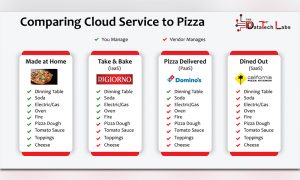Cloud computing is changing our lives in many ways. While the technology has been described and commented on at length technically, very few studies have focused on its impact on everyday life. I want to reflect on the effects of these systemic changes to our lives by highlighting some of these areas.
I recently had an experience that prompted me to write this article. We were trapped in a traffic jam on our way to an official meeting when I overheard my driver discussing WhatsApp data recovery with a friend. The friend was terrified of losing all his crucial communications after one of his acquaintance’s children deleted his WhatsApp. My driver advised him to reinstall the app and select the backup sync option. He was explaining to him that all our information is saved in one central location and that if we want to sync data, it is also saved and easily retrievable. He had no clue what the phrase Cloud computing meant technically, but I had a notion of how technology has converged in our lives.
What is CLOUD Computing?
Cloud computing whether we like it or not is here to stay in one form or another. Everyday life activities such as Banking, Email, Media Streaming, and Ecommerce all use the Cloud. On the Business side, Applications, Infrastructure, Storage, and Sales/CRM all have their presence out in the Cloud. Cloud computing is essentially the offering of an application or service that is offered over numerous devices, or locations.
Cloud Computing, as we all know, is the most recent version of modern processing, allowing you to view your documents and use computing power from anywhere in the globe as long as you have internet access. Cloud computing is a resource that is maintained in one location and accessed from anywhere in the world over the Internet. Cloud computing is defined as the delivery of an application or service across multiple devices or locations.
The uses of Cloud aren’t limited, it ranges from emails all the way to the deployment of an infrastructure. To make it clearer for you, we have outlined 11 features that you’ll use.
- Scalable Usage : Application examples: Netflix, Amazon Prime, Now TV
- Chat Bots : Application examples: Siri, Alexa, Google Assistant
- Communication : Application examples: Skype, WhatsApp, Emails
- Productivity : Application examples: Microsoft Office 365, Google Docs
- Business Process : Application examples: SalesForce, HubSpot, Marketo
- Back-up and Recovery : Application examples: Dropbox, Google Drive, iCloud, Amazon S3
- Application Development : Application examples: Amazon Lumberyard
- Testing and Development : Application examples: BlazeMeter, LoadStorm
- Big data Analysis : Application examples: Hadoop, Cassandra, HPCC
- Social Networking : Application examples: Facebook, Twitter, LinkedIn, Instagram, Pinterest
- Infrastructure : Application examples: Amazon Web Services, Rackspace
Demystify the Cloud
SaaS – Software as a Service vs. PaaS – Platform as a Service vs. IaaS – Infrastructure as a Service

Additional variance of services on cloud can be BaaS – Backup as a Service, KaaS – Knowledge as a Service, DRaaS – Disaster Recovery as a Service etc.
Now that we have understood the fundamentals of cloud computing, it’s time to decipher how does it impact our daily lives?
Social and Personal Impact
If you’ve ever wanted to send a large file to a friend, you’ve most likely used Dropbox or Send space to do so. If you use Google’s or Microsoft’s personal Gmail or Hotmail email services, your data is stored on Google’s or Microsoft’s cloud servers. Music and video live streaming, online gaming, and the Google search engine are living proof of how profoundly cloud computing has changed our lives. An occurrence in one area of the world can be broadcast to all parts of the globe. Because of cloud computing, we can live stream football matches or watch our favourite movies on Netflix. Cloud storage has grown so common that most individuals are unaware that they utilise it.
Impact on Education
Education institutions have quickly grasped the advantages of cloud computing, such as the ability to conduct billing, access data from anywhere, and store a large amount of data for less money. Cloud computing benefits education as well, as students now have access to cloud-based materials, websites, and communities, helping them to grow and develop further.
Impact on Business
The use of cloud computing to install enterprise applications is becoming progressively common. It enables businesses to manage, maintain, and secure important business resources while allowing easy access to these apps via a web browser. Businesses are increasingly relying on cloud-based information resources and social platforms for their information because of the cloud computing advancements and wide range of analytical skills. Cloud computing has also benefited economics, especially in underdeveloped countries.
Impact on the health sector
Talking about the healthcare industry, cloud computing is gaining traction. Its application is maintaining and exchanging patient data to save money on things like data storage equipment. Patients can also access their medical records through mobile phones and other ubiquitous devices. As a result, the medical industry has moved away from traditional intranets and toward cloud computing as a speedy and secure alternative.
Online Shopping
Every day, the number of people who shop online climbs. To give a better consumer experience and develop a better marketing plan, most online shopping platforms are employing the cloud to store critical client information. As a result of cloud computing, they make use of analytical data such as recent views or client recommendations.
Navigation
Navigation applications in our lives are GPS gadgets or mobile maps. Ever wondered how do they figure out where you are? To aid you, navigation applications save huge quantities of data and keep it up to date. When you use these technologies, you are inadvertently employing the cloud to assist you in moving from one location to another.
The conclusion is that the list of the above uses of cloud computing and its meaningful impact on day-to-day life is not exhaustive, it does provide a compelling reason to adopt the cloud over more traditional alternatives for increasing IT infrastructure flexibility, as well as leveraging big data analytics and mobile computing.


